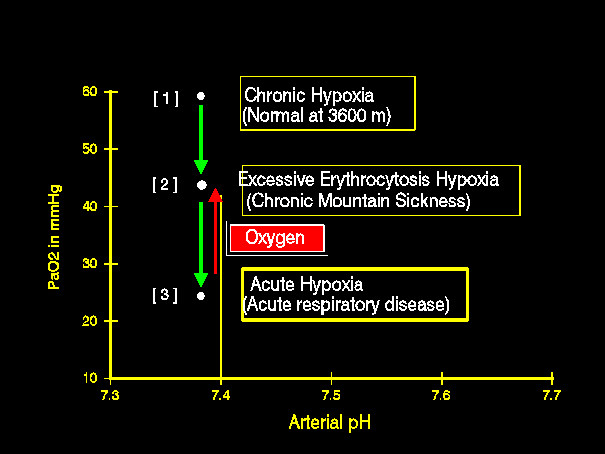
Zubieta-Castillo, G. and Zubieta-Calleja, G. HIGH ALTITUDE PATHOLOGY INSTITUTE (IPPA). La Paz, Bolivia
Many patients with EXCESSIVE ERYTHROCYTOSIS (EE), with hematocrits greater than 55 %, but not greater that 70 %, apparently can function normally. They work, play soccer, develop intellectual activities and frequently perform better than sedentary normal people. They request medical attention, only when they present symptoms similar to those of ACUTE MOUNTAIN SICKNESS (AMS), such as: headache, dyspnea, nausea, lassitude and indigestion. Without going higher they have been said to experience "sorojchi (AMS) in bed". Their arterial blood gases, may show extreme hypoxia with an oxygen arterial tension (PaO2) near 20 mmHg, with or without hypercapnia and a normal or acidotic pH. We have previously named this complication of EE, TRIPLE HYPOXIA SYNDROME (THS). It is due to: [1] Normal high altitude adaptation to hypoxia, [2] EE hypoxia (CMS) and [3] acute hypoxia that can be reversed by oxygen. The THS is similar to "surviving" in the summit of Mount Everest. It may be caused by viral infections (gripe) or some other acute respiratory disease, with malaise that lasts several days without treatment and typically is reversed by 24 hours of oxygen to PaO2 baseline values of their chronic condition with EE. The diagnosis is important, since the THS is an acute transitory condition, that when not recognized and treated with oxygen can possibly lead to cardiac, pulmonary or cerebral complications.

In the Triple Hypoxia Syndrome (THS) graph, PaO2 values showing the three levels of hypoxia. Twenty four hours of oxygen by mask reverse the THS to level 2.